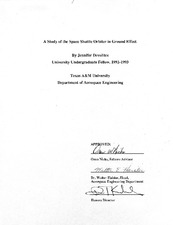| dc.description.abstract | A 4.05% model of the NASA Space Shuttle Orbiter was tested (Test 9238) at the Texas A&M University Low Speed Wind Tunnel (TAMU-LSWT) at various heights above the wind tunnel floor, in order to simulate the ground effect that occurs during landing. A primary goal of this investigation was to verify that the variable-height three-strut setup could be used for realistic ground effect testing.
Results for the Orbiter in ground effect included an increase in lift and drag and a nose-down pitching moment as the model was lowered to the floor for most positive angles of attack. Also, it was found that a change in elevon settings had a significant impact on the forces and moments, but a change in body flap deflection had very little effect on the lift, drag, or pitching moment.
The maximum lift-to-drag ratio of 3.7 occurred in ground effect around 13 degrees angle of attack. Additionally, the lift-to-drag ratio increased as the height/span decreased for positive angles of attack. Finally, the largest percent changes (from free stream conditions) with the model at ten degrees angle of attack were 45% for lift and 10% for drag when the model was nearest to the floor. The percent change in pitching moment varied from a 10% decrease to a 107% decrease, depending on the elevon deflection angle, indicating that a change in the elevon deflection angle affects the pitching moment much more than the lift or drag.
Two sets of wind tunnel data from previous tests and two sets of flight data were used for comparison. By these comparisons, results from Test 9238 correlated very well to the other data for lift coefficients, but not quite as well for drag or pitching moments coefficients. Other inconsistencies between Test 9238 and the other sources were 'dips' and trend reversals at some angles of attack. Data analysis indicated that the model setup and data reduction procedures were not responsible for the dips. Further analysis and testing may be necessary to completely-validate the setup for ground effect testing, but it was concluded that the variable-height three-strut setup produced good results. | en |


